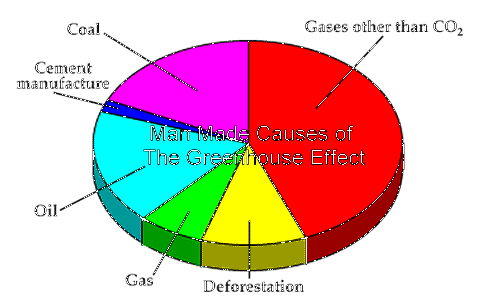CFCs and Global Warming.
As mentioned in my previous post, global warming is a direct cause of greenhouse gases, but where do these greenhouse gases come from? Global warming affects the animals, agriculture, and of course the human race. Although humans are one of the victims for global warming, we must remember that we are the main producers of these greenhouse gases, which in return disrupt the climate and cause catastrophic changes. Some of the main causes of global warming, that are caused by humans are electricity usage, factory pollutants and waste, driving cars, and chemical fertilizers. All of these methods are used because they are financially beneficial and provide faster mechanisms and delivery for the consumers. American civilians are known for using more than they need, which is one major reason as to why global warming exists. One of the most hazardous chemicals that affect global warming and then in return deplete the ozone layer, are chlorofluorocarbons.

The United States has one of the largest coal mine reserves in the world. It is estimated that we will be able to provide electricity for the next 200 years. Coal is the most abundant fossil fuel found in America, but it is nonrenewable. Although there are an unlimited amount of coal reserves located within the United States, Americans still need to learn how to limit their usage of electricity in order to help sustain the negative environmental impact of energy over consumption The main greenhouse gas that is caused from electricity usage within the home, such as a charger plugged into a wall or a TV that is always on, produces chlorofluorocarbons (CFCs). CFCs are organic compounds that contain carbon, chlorine, hydrogen and fluorine. When CFCs were first used in industries, global warming began to increase, which in return enhanced the size of the hole in the ozone layer. Since CFCs are man-made chemicals, they are a higher threat to the ozone layer in comparison to any other hazardous gas, such as carbon dioxide or methane. CFCs are transported in the stratosphere after being emitted to the surface. Scientists have been studying how CFCs directly impact global warming, and in their research they have found that cosmic-rays driven by electron-induced reactions of halogen molecules, creates a warming reactor effect of the overall temperature of Earth, creating drastic climate changes in naturally cold regions, such as the arctic.

CFCs were a major issue back in the early 1970s up until the late 1980s, in which the Montreal Protocol was enforced, because of how much pollution was transmitted into the air, due to factories overproducing CFCs. The Montreal Protocol was an international agreement designed to slow and reverse stratospheric ozone depletion for future generations, because it was such a major problem. The protocol called for at least a 50% reduction of CFC usage by 2000 from countries who agreed to the treaty. Since industries were not following the guidelines set by the Montreal Protocol, another agreement was made in the early 1990s, stating that all production of CFCs must cease immediately, with regards to an emergency use for medical purposes. Since many companies agreed to abide by these new regulations, the percentage of CFCs in the atmosphere, most importantly the stratosphere, have since lowered and the Antarctic ozone hole is predicted to be salvaged by 2050.

Present day society has since then dwindled down the usage of CFCs by taking measures into their own hands. Some examples include the absence of CFC chemicals in aerosol cans, or the fact that the chemicals used in refrigerators and air conditioners are not made with CFC products anymore. Although America is a consumer society that heavily relies on products that are unforeseen in other nations, there is still some hope that we can come as a nation and rebuild our social, economic and most importantly environmental impact as a whole. The steps to a rejuvenated nation are there, now all that’s left is to climb the monument of sustainability, resourcefulness and selflessness.

http://teeic.anl.gov/er/coal/restech/uses/index.cfm
http://planetsave.com/2009/06/07/global-warming-effects-and-causes-a-top-10-list/
http://www.skepticalscience.com/Could-CFCs-be-causing-global-warming.html
Recent Comments